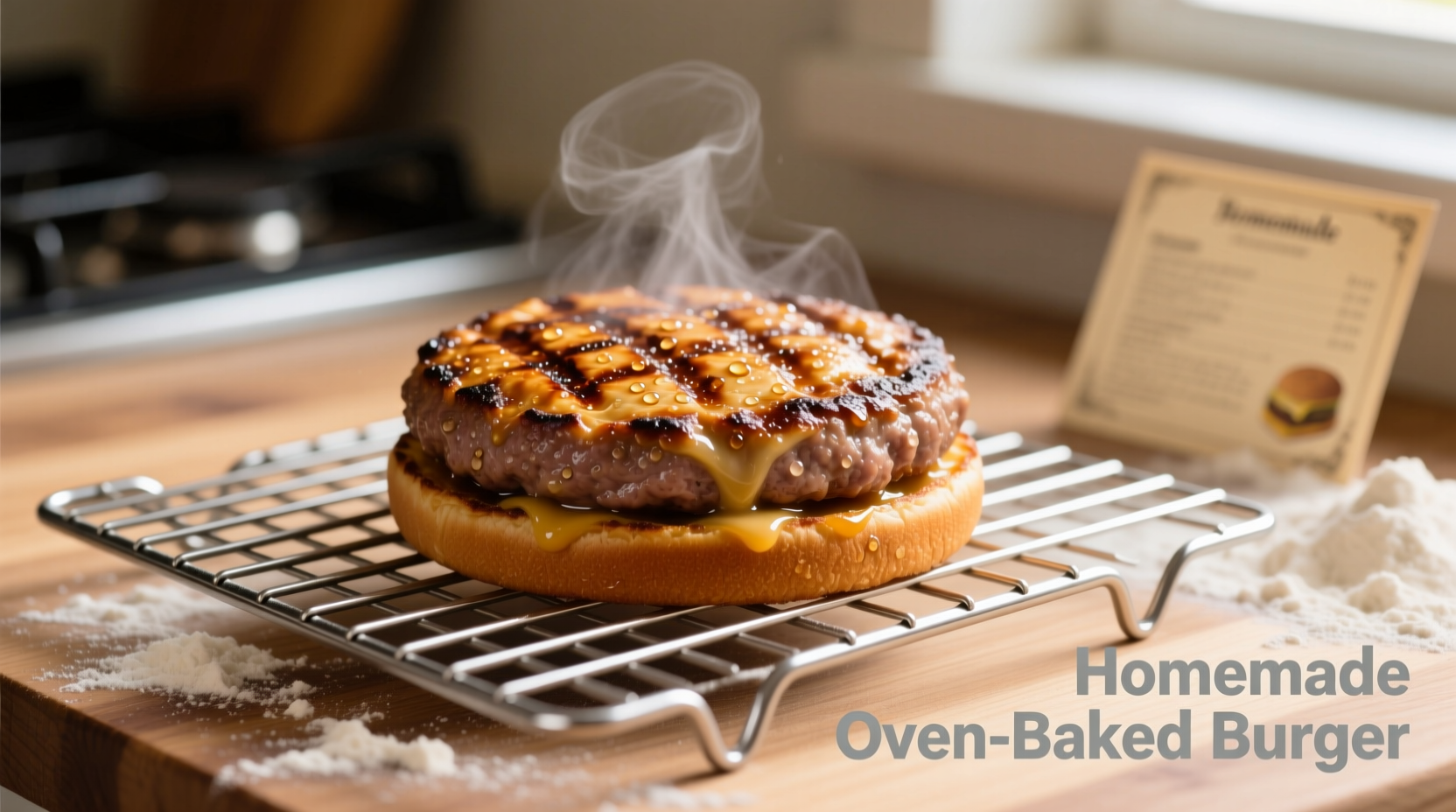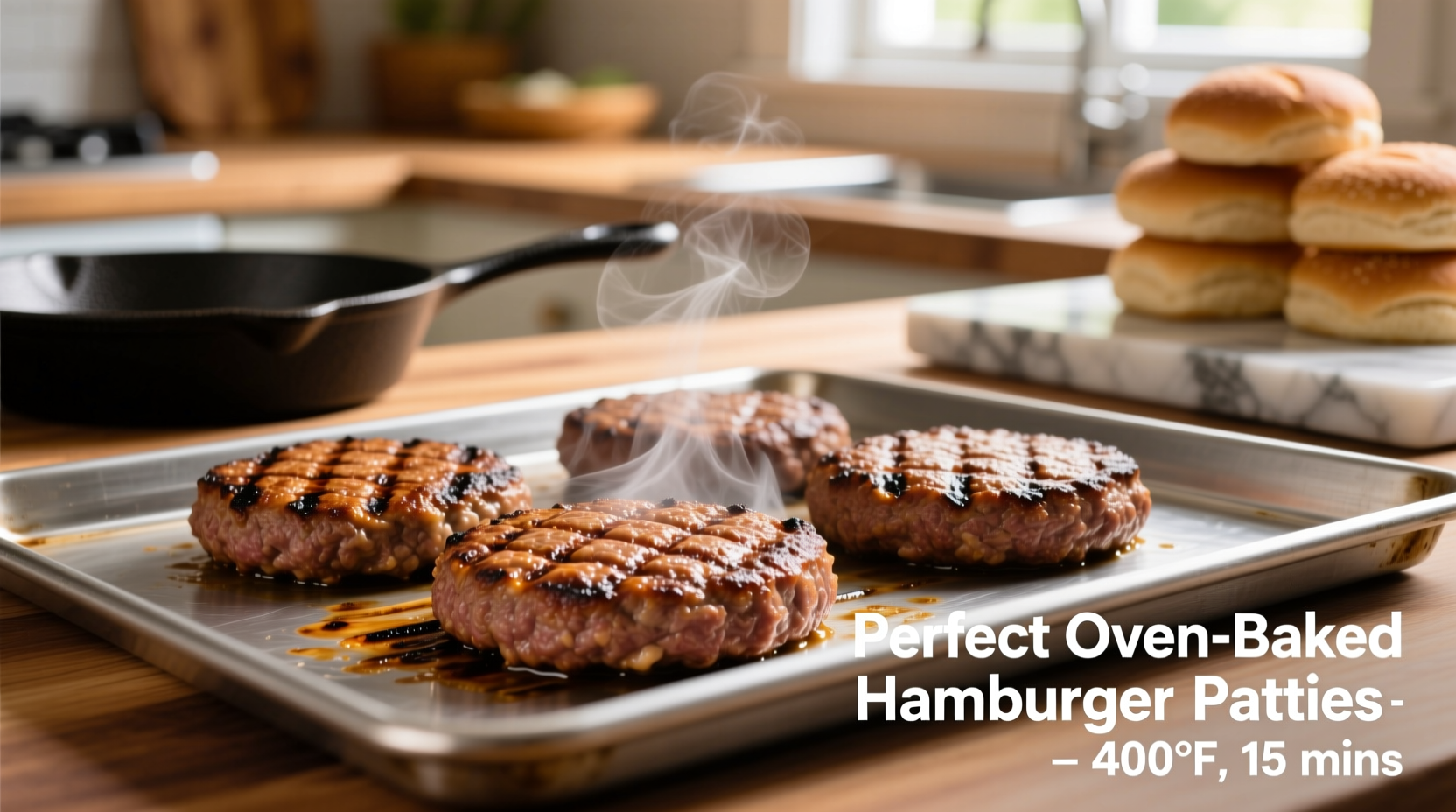Preheat your oven to 400°F (200°C), place formed hamburger patties on a wire rack over a baking sheet, and bake for 15-20 minutes until the internal temperature reaches 160°F (71°C). This foolproof oven method delivers evenly cooked, juicy burgers without flipping or constant monitoring.
The Smart Way to Bake Perfect Hamburger Patties
Forget messy stovetop splatters and uneven grill marks. Baking hamburger patties in the oven offers consistent results with minimal effort—ideal for weeknight dinners or feeding a crowd. Unlike pan-frying, the oven's gentle, even heat cooks patties thoroughly while locking in juices, resulting in restaurant-quality burgers every time.
Why Oven-Baked Burgers Outperform Other Methods
Many home cooks default to grilling or pan-frying, but oven baking solves common burger problems:
- No flare-ups from dripping fat causing burnt exteriors
- Hands-off cooking without constant flipping or monitoring
- Even cooking throughout the patty, eliminating raw centers
- Consistent results whether making one burger or a dozen
According to USDA Food Safety and Inspection Service guidelines, ground beef must reach 160°F (71°C) to eliminate harmful bacteria like E. coli. The oven's controlled environment makes hitting this critical temperature reliably straightforward.
Essential Preparation for Juicy Results
The foundation of a great oven-baked burger starts long before it touches heat. Follow these preparation steps for maximum flavor and texture:
Selecting the Right Ground Beef
Choose ground beef with an 80% lean to 20% fat ratio. This balance provides enough fat for juiciness without excessive shrinkage. Leaner blends (90% or higher) often result in dry, crumbly patties when baked. As culinary expert Harold McGee explains in On Food and Cooking, fat carries flavor and creates steam during cooking that keeps meat moist.
Shaping Perfect Patties
Divide your meat into 6-ounce portions (about 1.5 inches thick) and gently form into balls before flattening. Press a shallow 1/2-inch indentation in the center of each patty—this counteracts the natural tendency to balloon during cooking. Avoid overworking the meat, which compacts proteins and creates tough burgers.
| Patty Thickness | Recommended Baking Time | Internal Temp Target |
|---|---|---|
| 3/4 inch | 12-15 minutes | 150°F (66°C) |
| 1 inch | 15-18 minutes | 155°F (68°C) |
| 1.5 inches | 18-22 minutes | 160°F (71°C) |
The Foolproof Oven Baking Process
Equipment Setup
Line a rimmed baking sheet with aluminum foil for easy cleanup, then place a wire rack on top. The rack allows hot air to circulate completely around the patties, promoting even cooking and preventing steaming. For extra flavor, position a shallow pan of water on the oven's bottom rack to create gentle steam that keeps burgers moist.

Temperature and Timing
Preheat your oven to 400°F (200°C)—this higher temperature creates a desirable crust while cooking through efficiently. Place patties on the prepared rack with at least 1 inch between them. Bake for 15-20 minutes depending on thickness, checking internal temperature with an instant-read thermometer during the last few minutes.
Unlike stovetop methods, oven-baked patties typically don't require flipping. The even heat distribution cooks both sides simultaneously. If you prefer visible sear marks, flip once halfway through cooking, but this isn't necessary for flavor development in the oven environment.
Doneness Checkpoints
Insert your thermometer horizontally into the side of the patty to get an accurate reading. The USDA Food Safety and Inspection Service mandates 160°F (71°C) for ground beef safety, but many chefs pull burgers at 150-155°F (66-68°C) for medium doneness, as residual heat will continue cooking during resting.
Troubleshooting Common Issues
Preventing Dryness
If your burgers emerge dry despite following timing guidelines, consider these fixes:
- Increase fat content in your ground beef (aim for 20% fat)
- Add 1-2 tablespoons of ice-cold water per pound of meat before shaping
- Reduce oven temperature to 375°F (190°C) for thicker patties
- Place patties on a lightly oiled rack rather than directly on foil
Minimizing Shrinkage
All burgers shrink during cooking, but excessive shrinkage indicates problems:
- Over-handling: Form patties gently without compacting
- High heat: Lower oven temperature slightly if edges curl dramatically
- Wrong fat ratio: Adjust to 80/20 lean-to-fat ratio
- No indentation: Always press center dimple before baking
Serving for Maximum Enjoyment
Rest baked patties for 5 minutes before serving—this allows juices to redistribute throughout the meat. During this critical period, internal temperature will rise 5-10 degrees, reaching perfect doneness. Serve on toasted buns with your favorite toppings, but avoid heavy, cold ingredients that might cool the burger too quickly.
For meal prep efficiency, bake multiple batches and freeze cooked patties between parchment paper. Reheat directly from frozen in a 350°F (175°C) oven for 12-15 minutes—no thawing required.
When Oven Baking Isn't Ideal
While oven baking works beautifully for standard hamburger patties, certain scenarios call for alternative methods:
- Smash burgers: Require direct high-heat contact for proper crust formation
- Thin patty styles (like diner-style): Better suited to griddles
- Char-grilled flavor seekers: Traditional grill provides unique smoke infusion
For most home cooks seeking consistent, juicy results with minimal effort, however, the oven method delivers exceptional performance across various skill levels and kitchen setups.











 浙公网安备
33010002000092号
浙公网安备
33010002000092号 浙B2-20120091-4
浙B2-20120091-4